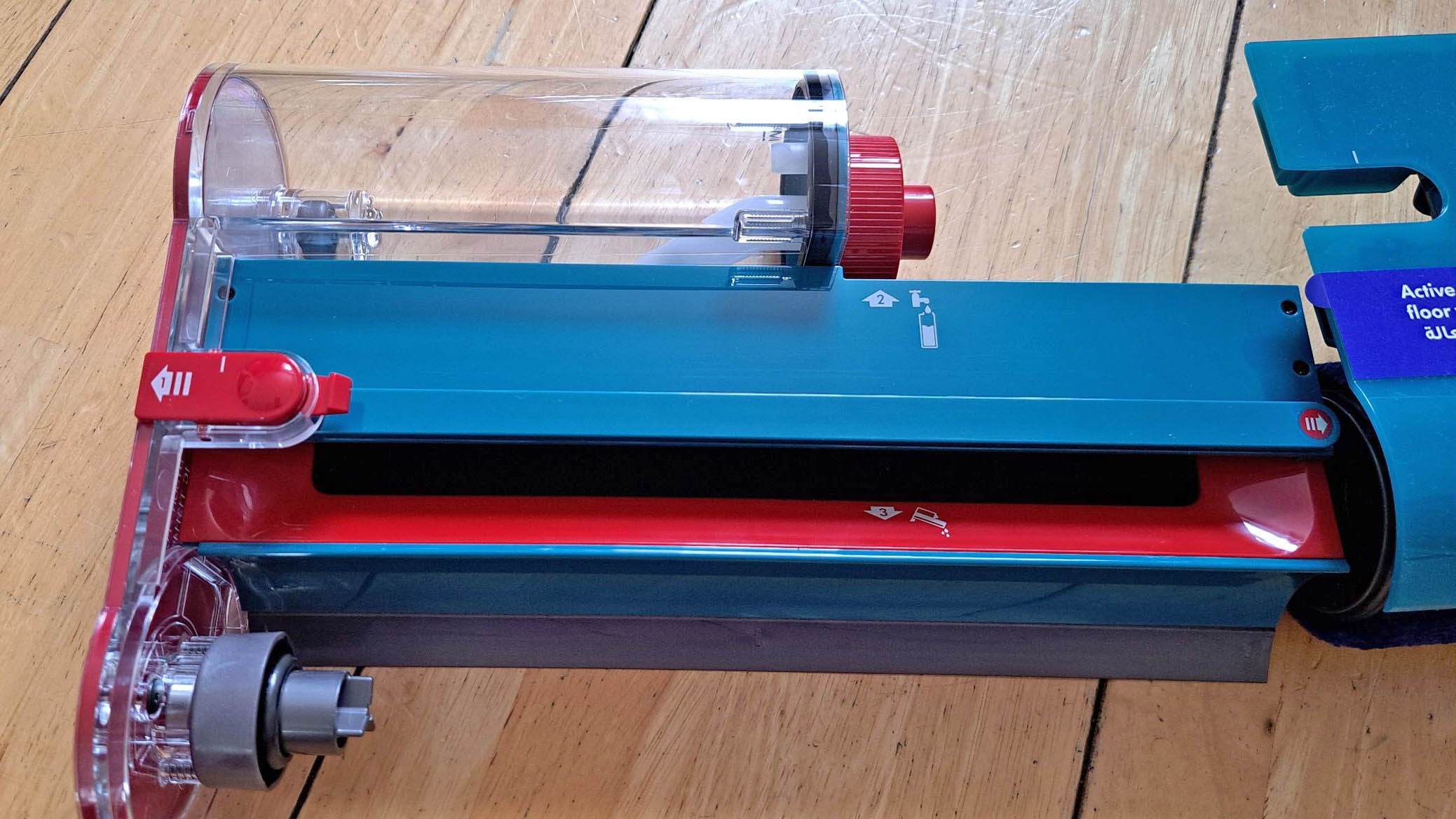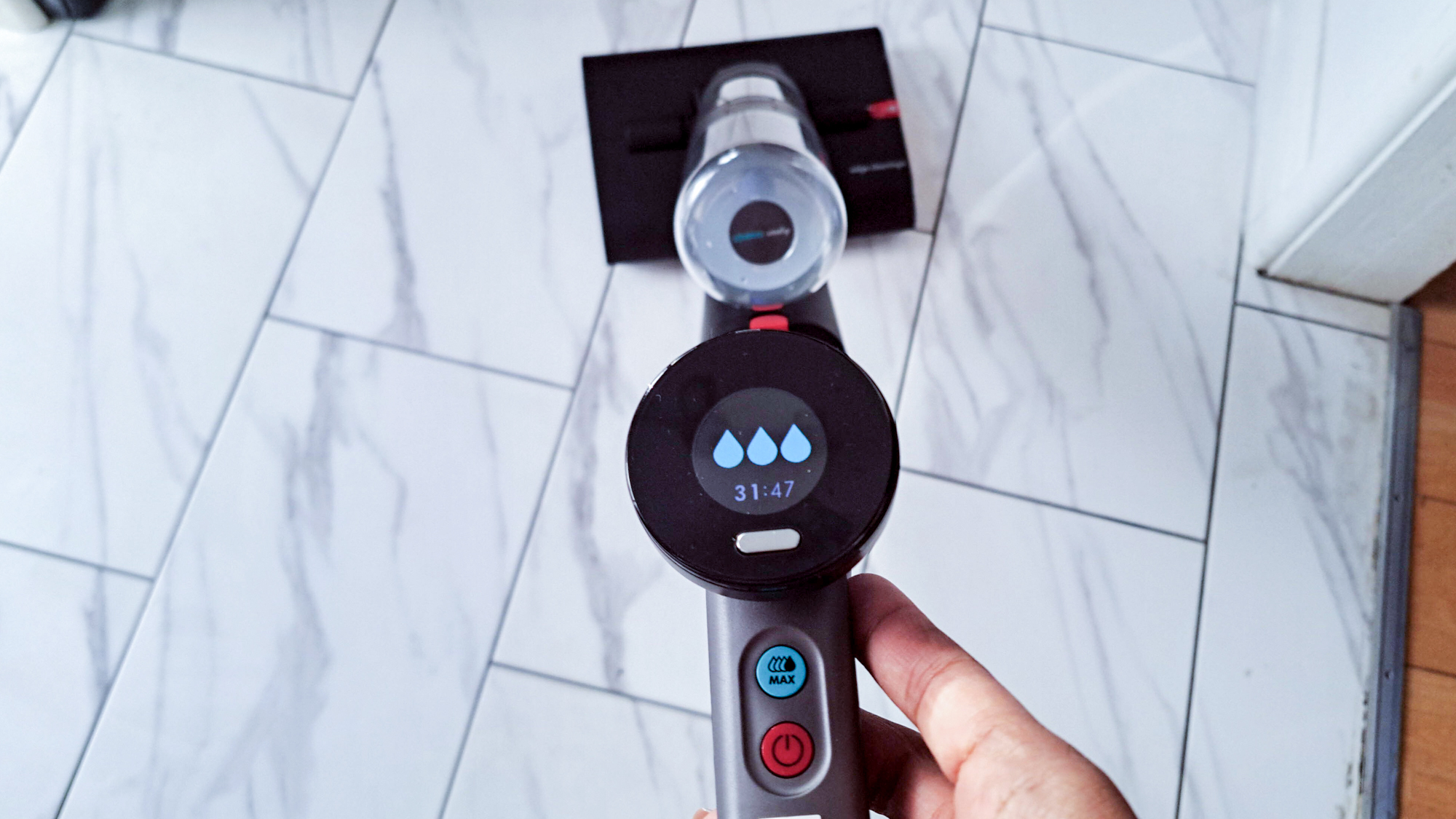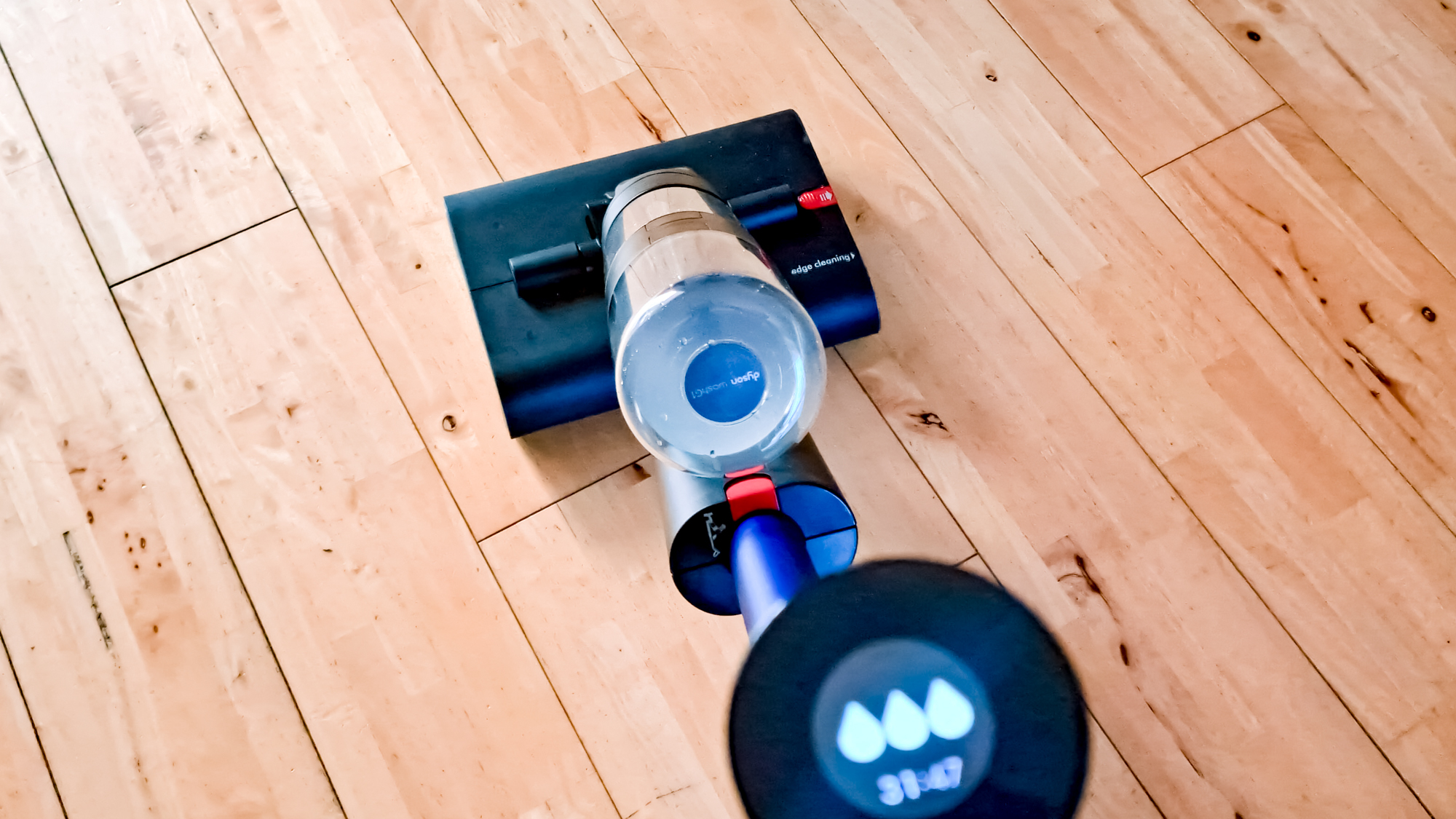Dyson V15s Detect Submarine vs. Dyson WashG1 — which wet cleaner is right for you?
Two of Dyson’s wet/dry vacuum cleaners go head-to-head


If you have mainly hard flooring or tiles, this Dyson WashG1 will wash your floors, and do all the hard work. It comes with a large water tank capacity, three power settings and a handy, self-cleaning function so you have one less thing to worry about. Squeaky cleanliness for a hefty price, but sure beats a mop and bucket.
Pros
- Impressive cleaning results and stain-removal
- Easy to use
- Intuitive screen
- Floors are quick to dry without streaks
- Auto self-cleaning cycle
Cons
- Does not clean carpets
- Bulky head doesn’t clean corners or fit under low furniture
- Rollers need replacing every six months
- Hefty price

Finally, a Dyson cordless stick vacuum that can vacuum carpets and mop at the same time. The Dyson Submarine comes with a range of attachments needed to clean carpets, upholstery and can even wash floors all in one session. Convenience at your fingertips.
Pros
- 2-in-1 design for wet dry head
- Powerful performance
- Easy to use around the home
- Battery lasts long
- Easy assembly
Cons
- Small water tank
- No auto self cleaning function
- No mounting spaces to store all the attachments
Wet and dry cleaners have gained huge popularity over recent years, promising to make light work of traditional mopping with a more efficient, all-in-one, cleaning experience. And while there has been much debate about whether traditional mopping is better for your floors than a wet and dry vacuum, there is no denying the incredible suction power, speed and versatility of these cleaners.
As Homes editor, and someone with mainly hard flooring, I've tested my fair share of wet and dry vacuums to see how they compare. Dyson is a name that has firmly made its mark as one of the best vacuum cleaners, and recently introduced two wet and dry models. The first was the Dyson V15s Detect Submarine, (a hybrid vacuum cleaner with wet/dry capabilities) , which was followed by the Dyson Wash G1 — the brand's first dedicated floor washer.
In fact, choosing between the two will depend on your needs and lifestyle, given the hefty $500 price difference. This is mainly due to the fact that the Dyson Submarine is essentially an upgrade of the V15 Detect Absolute — just with a wet/dry attachment head. While the Dyson WashG1 isn’t designed to tackle carpets at all. However, if you simply want to care for hard floors, we're here to help you decide which wet and dry cleaner is right for your home. I've tested both models to see how well they coped with my hard and tiled flooring. But, which one is better to wash your floors? Read on to find out.
Dyson V15s Detect Submarine vs. Dyson WashG1: Price and availability
Both the Dyson Submarine and Dyson WashG1 cleaners are available through Dyson.com directly and through retailers like Amazon. The Dyson Submarine has a retail price of $949.99 from the website, and can be picked up for $880 on Amazon.The Dyson WashG1 is currently available for $499 on the website only.
Considering there are plenty of wet and dry vacuum cleaners on the market, the Dyson WashG1 price may seem quite costly. This is especially the case when it doesn't come with any of the advanced features such as App-control or voice guidance that can be found on other models. However, if you have brand loyalty to Dyson, or simply after a high-powered, wet and dry vac, you can certainly expect a quality specification.
| Header Cell - Column 0 | Dyson Submarine | Dyson WashG1 |
|---|---|---|
| Price | $949 | $499 |
| Weight | 9 pounds | 10 pounds |
| Water tank capacity | 10 fl. oz | 33 fl. oz |
| Battery runtime | Up to 60 minutes | Up to 35 minutes |
Dyson V15s Detect Submarine vs. Dyson WashG1: Design
There are clear differences in the design between the two models. Firstly, the Dyson Submarine has a slimline cordless stick design, much like the Dyson V15s Detect Cordless, and weighs in at 9 pounds.
It also comes with a selection of cleaning heads/tools, including a standard digital motor bar cleaner head to tackle carpets, fluffy optic cleaner head to detect dust, hair screw tool, combination/crevice tool, and of course the Submarine mopping head and a drip tray to place it in. Basically, everything you need to handle both carpets and hard floors in one appliance is right at your fingertips.
Get instant access to breaking news, the hottest reviews, great deals and helpful tips.

The Dyson WashG1 on the other hand has an upright design with a large floorhead. Unfortunately, it doesn't come with any extra attachments, just a charging pad — and it's also lacks any fancy features, such as App connectivity.
It’s also slightly heavier to lift at 10 pounds, but it isn’t as cumbersome and bulky as most dedicated wet and dry cleaners. Plus, most of the weight comes from the large water tank that’s divided into two parts — one for the clean water (1L), and the other for dirty waste (800ml). However, it does have the very appealing, self-cleaning feature, which means you have one less thing to do.
Both models have motorized wet/dry roller heads that pick up liquids and debris, which are then extracted from the roller as these rotate. Overall, they both have a sleek, attractive finish, with the Dyson color scheme of silver and blue.
Winner: Dyson Wash G1

Dyson V15s Detect Submarine vs. Dyson WashG1: Ease of use
Setting up the wet/dry attachment is relatively easy. On the wet roller head, there is a red Quick-release button that you slide out the water chamber, unscrew the cap, and fill with clean water before replacing it. Unlike the traditional mop and bucket, remember not to use hot or lukewarm water, just room temperature — and no detergent such as dish soap.
Then you just use the cordless vacuum as normal by pressing the trigger. I found this easy to use and the swivel floor head was able to maneuver along the baseboards, and even go under low furniture. Emptying the waste is fuss-free, by removing the red dirty water tank cap to empty the extraction tray. Although, you still might have to get your hands dirty when rinsing the roller heads clean under the faucet.

On the other hand, the Dyson WashG1 water canister is much quicker to detach from the vacuum body and unscrew the lid of the clean water section to fill to the Max line. Then once you attach it back to the ‘capsule’, you click it back and it’s ready to go. Once you press the power button, set your hydration level and operate it by pulling the handle/wand down.
Similar to the Dyson Submarine, the LCD display shows you handy information such as when to ‘fill clean water tank’ and hydration modes — low, medium and high, which can be switched by the silver button underneath. There’s also a Max mode that you push and hold the blue water droplet button next to the power button to activate. Then once you've finished cleaning your floors, simply detach the tank and only empty out the dirty water section - giving it a quick rinse if you choose.
The only caveat is the Dyson WashG1 might be a struggle for some to lift and carry around a large home, especially with a full water tank. However, setting up and cleaning this model proved to be more hassle-free overall. It also has the added bonus of a self-clean feature that is convenient.
Winner: Dyson Wash G1

Dyson Submarine vs. Dyson WashG1: Performance
Performance-wise, both models do a great job in cleaning different types of hardwood and tile floors. With their swivel head mechanism, it was easy to maneuver to remove surface marks and dirt in a few swoops. But while the Dyson Submarine left clean-looking results, the Dyson WashG1 gave a more powerful and robust performance. It felt more responsive and tackled heavy-duty, sticky stains with ease. In addition, it didn't leave behind wet streaks or water patches, and the floors seemed to dry faster in comparison.

Another notable difference of the Dyson Submarine is that if you pause mid-flow, the roller can leave grimy water streaks on the floor, as the suction has essentially stopped. So you'd have to keep the suction going to avoid cleaning the area again to remove grimy streaks.
Nevertheless, the Dyson Submarine is a quick and convenient option, and its roller head has the advantage of reaching under low rise furniture such as a sofa or bed. On the other hand, the Dyson WashG1 struggled with getting into awkward spots with its much bulkier head - and there isn't a separate attachment that can tackle these spots. So in terms of getting a thorough, deep clean, you might still have to get the mop and bucket out of retirement.
Winner: Dyson WashG1

Dyson Submarine vs. Dyson WashG1: Verdict
If you have a combination of carpets and hard floors, using the Dyson Submarine will certainly make a great, multi-purpose vacuum cleaner. Not only will it deep clean your carpets and upholstery, but you can easily swap out the head to wash your hard floors in the same cleaning session. However, it does have a smaller water tank capacity, which might be limiting for larger room coverage.
And while it managed to get rid of minor stains and dirt on hard floors, it still struggled to cope with heavy-duty messes. With that being said, the Dyson Submarine would be ideal for tackling smaller messes or spillages, especially if you have young children or pets in the home. It is lighter to carry around the home and is more versatile to use on both carpets and hard floors (with the right attachment heads).

However, if like me, you have mainly hard flooring and have trouble staying on top of the mopping routine, the Dyson WashG1 wins hands-down for its sheer power, efficiency and water efficiency. Not only did it deliver spotless results, but left the floors dry and streak-free in less time. What's more, I still had sufficient clean water left after cleaning the whole house. It's also straightforward to use and maintain, and its 35 minute run-time is still adequate for a family home. Plus, its self-cleaning feature is super convenient. It might not have all the fancy bells and whistles of other wet and dry vacuum cleaners, but it's certainly a winner for your hard floors.
Winner: Dyson Wash G1
More from Tom's Guide
- How to choose the right vacuum cleaner — 7 things to consider
- For hands-free cleaning, check out the best robot vacuums
- Plus, how to clean your Dyson's filter

As the Homes Content Editor, Cynthia Lawrence covers all things homes, interior decorating, and garden-related. She has a wealth of editorial experience testing the latest, ‘must-have’ home appliances, writing buying guides and the handy ‘how to’ features.
Her work has been published in various titles including, T3, Top Ten Reviews, Ideal Home, Real Homes, Livingetc. and House Beautiful, amongst many.
With a rather unhealthy obsession for all things homes and interiors, she also has an interior design blog for style inspiration and savvy storage solutions (get rid of that clutter!). When she’s not testing cool products, she’ll be searching online for more decor ideas to spruce up her family home or looking for a great bargain!
